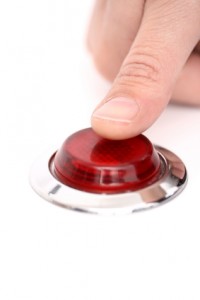 I often hear stories about button pushers. I have them myself. When you have an automatic, negative response to something, this often indicates a hypersensitivity that’s referred to as “getting your buttons pushed.”
I often hear stories about button pushers. I have them myself. When you have an automatic, negative response to something, this often indicates a hypersensitivity that’s referred to as “getting your buttons pushed.”
Usually these sensitivities have developed due to hurtful childhood experiences, such as repeatedly being criticized, rejected or controlled. For example, if your parents were very controlling, when someone tells you to do something you may resist—often subconsciously. Because so much of our thoughts and behavior are generated sub-consciously (estimates are as high as 90%), leaders can benefit from knowing what to do.
How well do you manage your buttons being pushed?
Answer the following two sets of questions, true or false.
Set 1
-
When my buttons get pushed, I tend to shut down and withdraw.
-
When someone hurts me—even when I know it was unintentional—I lash out at them or blame myself.
-
I hate it when someone tells me I’m “too sensitive.”
-
When someone says or does something that triggers the feelings connected to an old emotional pain, it takes me a long time to let go of it and feel centered again. I often carry resentment.
-
Sometimes I have no idea why I do what I do—I just can’t control myself.
-
Once someone pushes my buttons, that’s it—my wall goes up and stays up. I feel like a powerless little kid.
Set 2
-
When old feelings are triggered by something in the present, I take a deep breath, acknowledge that old feelings have been activated, get myself to a safe and comfortable environment and seek the support I need.
-
Rather than feeling victimized and blaming someone for pushing my buttons, I, again, take a deep breath, and then take an honest look at myself to see what I can learn from the situation.
-
I’ve worked to uncover old, painful issues so that I can release what was triggered and not feel at the mercy of my emotional response.
-
When I feel triggered, it often has nothing to do with the person who pushed my buttons.
-
I’m familiar with my most common “buttons”; I recognize them more quickly now and am less reactive.
-
When my buttons do get pushed now, I am able to see the unresolved issues needing my attention.
-
I feel like an empowered adult when I can courageously look at my emotional triggers and work through them.
If you answered “true” more often in Set 1 and “false” more often in Set 2, you may wish to learn how to deal more effectively when your buttons get pushed and how to release their charge.
5 tips to deal more effectively when your buttons are pushed:
-
 Notice the circumstances or situations in which you are repeatedly “reactive.
Notice the circumstances or situations in which you are repeatedly “reactive. -
Write them down. Observe any patterns.
-
Before the next “button-pushing” trigger, prepare yourself by creating an intention to become peaceful and calm, i.e. “I am peaceful and calm when I am face to face with so and so…”
-
Prior to the meeting visualize the upcoming encounter in detail
-
Breathe deeply as you prepare and practice PRIOR to the encounter
This works because the brain cannot tell the difference between imagination and reality.
By preparing and practicing what you consciously want, you will prepare the subconscious to deliver when the real situation is present.
For additional resources in accessing the Natural Leader within you, apply for a “Breakthrough Your Barriers” Strategy Session.
We invite your comments on how you manage through the “button-pushers.”

